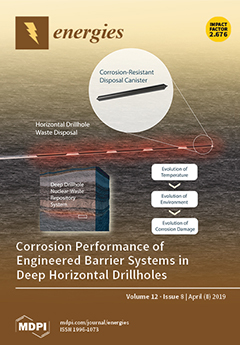The PV hosting capacity of low voltage feeders is restricted by voltage and current limits, and in many cases, voltage limit violations are the limiting factor for photovoltaic integration. To control the voltage, local Volt/var control strategies absorb or inject reactive power, provoking an additional current. This study analyzes the hosting capacity increase potential and the associated additional grid losses of local cos
φ(
P)- and
Q(
U)-control of photovoltaic inverters, and of local
L(
U)-control of inductive devices and its combination with
Q-Autarkic prosumers. Therefore, four theoretical and one real low voltage test-feeders with distinct structures are considered: long overhead line, short overhead line, long cable, short cable and branched cable. While the theoretical test-feeders host homogeneously distributed PV-plants, the real one hosts heterogeneously distributed PV-plants. Each test-feeder is used to conduct load flow simulations in the presence of no-control and the different control strategies separately, while gradually increasing the PV-penetration. The minimum PV-penetration that provokes voltage or current limit violations is compared for the different control strategies and test-feeders. Simulation results of the theoretical test-feeders show that the hosting capacity increase potential of all local Volt/var control strategies is higher for the overhead line feeders than for the cable ones. Local
L(
U)-control, especially its combination with
Q-Autarkic prosumers, increases the hosting capacity of all low voltage test-feeders significantly. The PV-inverter-based local Volt/var control strategies, i.e.,
Q(
U)- and cos
φ(
P)-control, enable lower hosting capacity increases; in particular, cos
φ(
P)-control causes high additional currents, allowing the feeder to host only a relatively small PV-module rating per prosumer.
Q(
U)- and cos
φ(
P)-control are not sufficient to increase the hosting capacity of the long cable feeder significantly; they provoke high additional grid losses for the overhead line test-feeders. Meanwhile,
L(
U)-control, especially its combination with
Q-Autarkic prosumers, increases the hosting capacity of the long cable feeder significantly, causing high additional grid losses during peak production of PV-plants. Regarding the real test-feeder with heterogeneously distributed PV-plants, on the one hand, the same trend concerning the HC increase prevails for the real branched cable test-feeder as for the theoretical short cable one. On the other hand, higher losses occur for the branched feeder in the case of
L(
U)-control and its combination with
Q-Autarkic prosumers, due to the lower voltage set-points that have to be used for the inductive devices. All in all, the use of local
L(
U)-control, whether combined with
Q-Autarkic prosumers or not, enables the effective and complete utilization of the existing radial low voltage feeders.
Full article





